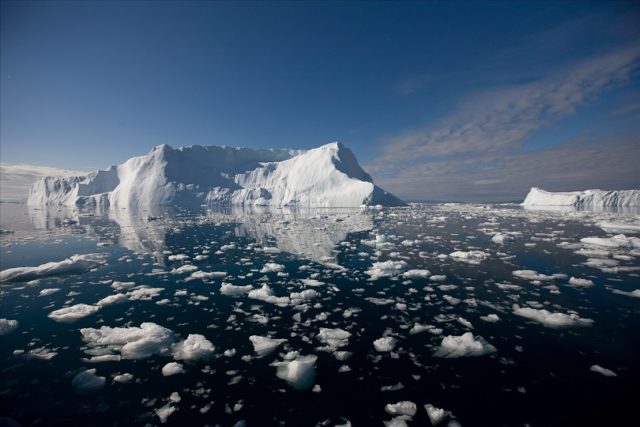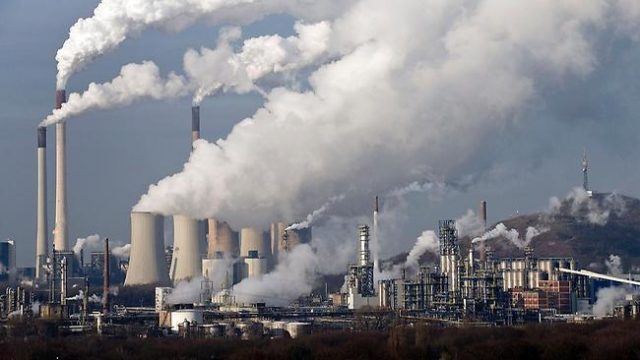Climate change skeptics might make a lot of noise, but the scientific consensus on the matter is pretty unassailable. 97% of climate scientists agree that climate change is an on-going man-made phenomenon. No one knows exactly how serious the problem will become, but there are plenty of reasons why you should be concerned.
10. We’ll have to Re-draw the Map of the World
Around 2% of the world’s water is currently ice. That might not sound like such a huge proportion, but if it were to melt sea levels would rise around 70 meters. Climate change is already hitting the Arctic hard, and it’s estimated that it could be ice free during summer by 2050.
Not only are some of the world’s largest cities like New York City and Miami in serious danger, but entire low-lying countries such as the Philippines could be lost forever. Considering that China and India also have huge urban populations on precariously low ground, the possibility of hundreds of millions of climate change refugees being created is very real.
9. A Threat to the World’s Supply of Food
The world’s population recently climbed above seven billion people, and that figure is expected to increase by another two billion in the next 50 years. Every one of them will need to eat. Add increasing life expectancy and decreasing infant mortality, and by 2050 the world might need to produce 70% more food than it does now. Unfortunately, climate change is likely to have a serious impact on the Earth’s ability to meet this goal.
Even aside from the worry that many of the best growing regions may have been submerged beneath rising sea levels or turned to desert by rising temperatures, our staple crops are at risk. Around half the calories consumed around the world come from just corn, wheat, soy and rice. Unfortunately, production of all of these is expected to fall as a result of climate change and pollution.
These changes will hit poorer nations hard, but even developed countries might have to re-educate themselves in terms of their food consumption. The meat and dairy industries are a huge driver of global warming, and could become unsustainable in the near future.
8. Arctic Carbon Release
Carbon dioxide is naturally present in the Earth’s atmosphere, but since the beginning of the industrial revolution its concentration has increased by a third. This is bad news, as carbon dioxide blocks in heat and causes the planet to warm up, leading to the famous greenhouse effect. Governments are slowly waking up to the danger and making efforts to reduce the amount of carbon dioxide released into the atmosphere. Some progress is being made, so a massive influx of carbon dioxide into the atmosphere would be disastrous. Unfortunately, it’s also a possibility.
The arctic acts like a gigantic safety deposit box for the world’s carbon. Its frozen soil holds up to 1,850 petagrams of the stuff. That’s a staggering amount — a petagram is equivalent to one billion metric tons, and all human activity since 1850 has only emitted a relatively modest 350 petagrams. As climate change causes the Arctic to warm up, the permafrost is going to melt and set its carbon free. If any significant portion of the arctic carbon does manage to escape, it would massively amplify the effects of climate change with catastrophic consequences for humanity.
7. Ocean Acidification
Not all of the carbon dioxide we produce ends up in the atmosphere — about a third of it is absorbed by the world’s oceans. A certain amount of carbon is needed in the oceans, as many organisms use it to make their shells and skeletons. However, too much carbon causes the water to become more acidic. Since the beginning of the industrial revolution the acidity of our oceans has increased by around 30%, and the problem is likely to become considerably worse by the end of the century.
It’s impossible to say exactly what long-term effects the new PH values of our seawater will have on the creatures that live there, but it’s safe to assume it will not be beneficial. Shellfish and coral seem to be particularly affected, and any significant loss in their numbers would reverberate all the way up the food chain.
6. Mass Extinctions
Ultimately, extinction is the natural course of things on Earth. The fossil record demonstrates that the extinction rate is usually very low, with around one species in every million succumbing each year. But occasionally things get a good deal more deadly, and much of life on Earth can be wiped out in a remarkably short time. So far there have been five such mass extinctions, but research also indicates that there’s a correlation between these events and global warming.
Some scientists have argued that the Earth is already entering a sixth mass extinction. With so many species threatened by habitat destruction, pollution and hunting, the increasingly drastic effects of climate change will push many of them beyond the point of no return. Amphibians are already being hit particularly hard, and the extinction of the golden toad and the harlequin frog have been linked to climate change. They are likely to be amongst the first of many.
5. Extreme Weather
Climate change isn’t just about the planet getting a few degrees warmer — it’s about the increase in extreme weather. Droughts, heatwaves, floods and hurricanes are all becoming more common and intense. A recent study by the International Panel on Climate Change concluded that there’s a link between climate change and extreme weather.
As extreme weather becomes more common the cost, both financial and human, will increase. In an average year, extreme weather kills about 106,000 people and costs $184 billion. These figures will rise as the effects of climate change become more pronounced. The impact will be felt worldwide, but disproportionately so in developing countries that don’t have the resources or the infrastructure to cope with extreme weather events as they become the new normal.
4. A More Violent World
When climate change really starts to bite, there are going to be a lot of people on the move as drought and flooding make whole regions inhospitable. War is almost inevitable, as populations on the move will clash with existing inhabitants over land and resources. The process may have already started, with the war in Syria being linked to drought brought on by climate change. A controversial study has also linked climate change to an increase in assaults and other violent crime. Why this might be the case isn’t clear yet, but it doesn’t bode well.
3. Shut Down of the Global Conveyor Belt
Evidence suggests that Earth can undergo vast climate change in the geological blink of an eye. The mechanics of how and why aren’t yet fully understood, but many scientists look towards thermohaline circulation as the culprit. Also known as the global conveyor belt, it’s the process that slowly moves water around the planet. Warm surface waters are gradually moved north and down towards the ocean floor, while cold nutrient-rich waters head south and rise. It’s a vast process, with 45 million cubic meters of water per second being moved from ocean floor to surface. It takes 500 years, but the global conveyor belt circulates all the waters in the world’s oceans.
Occasionally, perhaps as a result of climate change, the circulation shuts down. If this were to happen, temperatures in the North Atlantic would plummet by as much as 10 degrees Celsius, leaving Western Europeans wondering how to grow crops from under a blanket of snow. Crops would fail and weather patterns would go haywire across the globe. And if we couldn’t find a way to get the conveyor belt moving again, there would be no more distribution of nutrients throughout the oceans. The entire marine ecosystem would be in danger of collapse.
2. It’s Already Costing Billions
No one knows exactly how much it will cost to deal with the effects of climate change, or to re-structure the world economy so we don’t add to the damage that’s already been done. However, the threat is serious enough that the most expensive option might be to do nothing at all. Climate change is already linked to the deaths of 400,000 people each year, and it comes with an annual bill of $1.2 trillion. The costs are only set to rise. Unfortunately, it won’t be fairly distributed. Developing countries are expected to be hit hardest, while many of the world’s biggest polluters will get away with a smaller bill.
1. Climate Hacking
No one can predict how much our climate will change, or precisely what the consequences will be. But if things get really bad there might be a way to stave off the symptoms, albeit without addressing the underlying causes.
Geo-engineering, also known as climate hacking, offers the prospect of holding off the effects of the damage we’ve already done. It’s an effort to directly alter the natural systems of the planet. One proposal is to pump vast amounts of sulfur into the atmosphere. This would mimic the effects of a huge volcanic eruption, and the cooling influence eruptions have on the planet as the particles block out sunlight. It wouldn’t reduce the amount of carbon in the atmosphere, but it might cancel out its effects.
Although it might be tempting to view climate hacking as a magic bullet, it should be regarded as a weapon of last resort. Stuffing the atmosphere full of ash year after year might have any number of unforeseen consequences, and we might well only succeed in making things worse.









